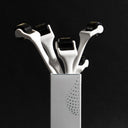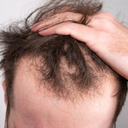Shampoo and conditioner are great, but sometimes your hair needs extra care. Whether it’s frizzy, dry, damaged, or thinning, the right treatment can make a big difference.
From smoothing frizz to repairing breakage, there are plenty of options—but which one is right for you?
This guide breaks down 11 effective hair treatments to help you find the best fit for your hair needs.
Table of content
Understanding your hair type & common hair concerns
Before choosing a treatment, it's important to know what kind of hair you have. Different hair types react differently to products and treatments, so getting this right can save you time, money, and frustration.
Hair types:
- Straight hair – Smooth, often shiny, but can get oily quickly.
- Wavy hair – A mix of straight and curly, tends to frizz in humidity.
- Curly hair – Defined curls that need moisture and can be prone to dryness.
- Coily hair – Tight curls or kinks that are fragile and need extra care.
Each type comes with its own set of challenges. Straight hair might look limp without volume, while curly hair often struggles with dryness and tangles.
Knowing where your hair fits in can help you pick treatments that work instead of ones that leave you disappointed.
Common hair concerns
- Frizz – Often caused by humidity, lack of moisture, or heat damage.
- Dryness – Hair feels rough, brittle, and lacks shine.
- Breakage – Weak strands that snap easily, usually due to heat, chemicals, or lack of protein.
- Thinning hair – Hair sheds more than usual, leading to less volume.
- Oily scalp – Produces too much sebum, making hair look greasy.
- Colour damage – Hair becomes dry and weak after repeated dyeing or bleaching.
If any of these sound familiar, don’t worry—there’s a treatment for it. Let’s go through the best options based on your needs.
As your leading source for hair health information over the past 4 years, we never compromise on accuracy. When it comes to your health, you deserve information you can truly rely on - and earning your trust is our top priority.
Here's how Scandinavian Biolabs ensures every piece of content meets the highest standards of accuracy and integrity:
- Credentialed Experts: Our reviewers are actively practicing doctors and medical researchers
- Stringent Reviews: Content undergoes rigorous editing by subject specialists and review by a practicing doctor.
- Evidence-Based: We rely on well-established research from trusted scientific sources like peer-reviewed journals and health authorities.
- Full Transparency: Our editorial standards, writer credentials, reviewer credentials, correction process, and funding are all publicly documented.
- Independent Voice: While we do promote products, we operate in a vacuum to business operations. Our main goal is just an unwavering commitment to providing medically-sound guidance.
You can count on Scandinavian Biolabs to consistently deliver the trustworthy health information you deserve. Read our Editorial Standards.
Different types of hair treatments & their benefits
Some treatments focus on smoothing, while others repair damage or hydrate dry strands. Here’s a breakdown of the most effective options.
1. Keratin treatment
If your hair gets frizzy the second you step outside, keratin treatment might be the fix. This process coats the hair with a keratin solution, which is then sealed in with heat, making strands smoother, shinier, and easier to manage.
It works especially well on thick, wavy, or curly hair that tends to get unruly.
The results can last up to three months, cutting down styling time significantly. But keep in mind, some versions contain formaldehyde, which isn’t ideal for sensitive scalps.
If you want a sleek, polished look without daily flat ironing, this could be a game-changer.
Pros:
- Cuts down frizz significantly
- Makes hair smoother and shinier
- Reduces styling time
- Lasts up to 3 months
Cons:
- Can contain harsh chemicals (like formaldehyde in some versions)
- Not ideal for very fine or thin hair
2. Nanoplastia treatment
Think of nanoplastia as a healthier alternative to keratin. It smooths and strengthens hair using amino acids and proteins, without the harsh chemicals found in traditional keratin treatments.
The result? Soft, straight, and manageable hair that still has a natural movement.
This treatment lasts longer than keratin—up to six months—but requires sulfate-free shampoo to maintain the effect.
If you want silky hair without the risk of chemical damage, nanoplastia is worth considering.
Pros:
- No harmful chemicals like formaldehyde
- Works on all hair types
- Provides long-lasting shine and smoothness (up to 6 months)
- Strengthens the hair from the inside out
Cons:
- Requires a specific sulfate-free shampoo for maintenance
- Might not work as well on extremely curly hair
3. Hair botox
Despite the name, hair botox has nothing to do with injections. Instead, it’s a deep-conditioning treatment packed with proteins, vitamins, and amino acids that repair damaged hair.
It fills in gaps in the hair cuticle, making strands smoother, shinier, and more resistant to breakage.
Unlike keratin, this treatment doesn’t straighten hair but helps control frizz while keeping natural curls intact.
It’s a great choice if you want your hair to feel healthier without altering its natural texture.
Pros:
- Hydrates and repairs damaged strands
- Reduces frizz without straightening the hair completely
- Adds volume and shine
- Works for all hair types
Cons:
- Results may not last as long as keratin (around 4 months)
- Can be expensive in salons
4. Protein treatment
If your hair snaps easily when you brush it, it’s probably lacking protein. Protein treatments help rebuild the structure of weak, brittle hair, making it stronger and more resilient.
They’re especially useful for chemically treated or heat-damaged hair that needs serious repair.
You can get a protein treatment at a salon or use DIY masks at home.
But be careful—too much protein can make hair feel stiff, so balance it out with deep conditioning.
Pros:
- Strengthens weak, brittle hair
- Reduces breakage and split ends
- Can be done at home or in a salon
- Works well for chemically treated hair
Cons:
- Too much protein can make hair feel stiff or dry
- Needs regular deep conditioning to balance moisture
5. Deep conditioning
When your hair feels dry, rough, or lifeless, a deep conditioning treatment can bring it back to life. These treatments penetrate the hair shaft, adding moisture and softness.
They’re perfect for anyone dealing with dullness, frizz, or split ends.
You can use a store-bought deep conditioner or make one at home using ingredients like avocado, honey, and coconut oil.
While the results don’t last long, regular deep conditioning can keep your hair looking and feeling healthy.
Pros:
- Adds deep hydration
- Restores shine and softness
- Easy to do at home
- Works on all hair types
Cons:
- Temporary results (lasts around 3 weeks)
- Needs regular application for lasting benefits
6. Bond-building treatments
Bond-building treatments like Olaplex and K18 go beyond regular conditioners.
They repair broken hair bonds caused by heat, bleach, and chemicals, making them ideal for anyone with damaged or overprocessed hair.
Unlike traditional treatments, these products work at a molecular level, meaning they actually fix the hair from the inside rather than just coating it.
They take time and consistency, but the results can be impressive.
Pros:
- Repairs damaged hair from the inside out
- Reduces breakage and split ends
- Can be used on colour-treated hair
- Strengthens hair over time
Cons:
- More expensive than traditional treatments
- Requires consistent use for best results
7. Scalp detox & exfoliation
Healthy hair starts with a healthy scalp. If you use a lot of styling products or struggle with itchiness, dandruff, or excess oil, a scalp detox can help.
It removes buildup and dead skin, giving your hair a fresh start.
Exfoliating your scalp stimulates hair growth by unclogging hair follicles.
Some treatments include scrubs, while others use ingredients like apple cider vinegar or tea tree oil to cleanse the scalp.
Pros:
- Helps with scalp itchiness and dandruff
- Improves hair growth by unclogging follicles
- Can reduce excess oil production
- Leaves the scalp feeling refreshed
Cons:
- Needs to be done regularly for lasting effects
- Can be drying if overused
8. Hot oil treatment
A simple yet effective treatment, hot oil therapy helps moisturise and strengthen dry, brittle hair.
It involves warming up natural oils (like coconut, argan, or olive oil) and massaging them into the scalp and strands.
Hot oil seals moisture into the hair, making it look shinier and feel softer. It’s an easy at-home treatment, but it works best when done consistently.
Pros:
- Deeply hydrates and strengthens hair
- Adds shine and softness
- Easy and affordable to do at home
- Helps reduce split ends
Cons:
- Can make fine hair feel greasy
- Needs to be washed out thoroughly
9. Gloss & toning treatments
If your hair colour looks faded or dull, a gloss or toner can refresh it.
These treatments add shine and adjust tone, whether you have dyed or natural hair.
A clear gloss adds shine, while a toner neutralises unwanted tones (like brassiness in blonde hair). The effects last a few weeks, so they require some upkeep.
Pros:
- Enhances colour vibrancy
- Adds instant shine
- Can be done in a salon or at home
- Works on both natural and colour-treated hair
Cons:
- Temporary (lasts about 4–6 weeks)
- Requires maintenance to keep colour fresh
10. Hair relaxers & perms
If you want to permanently straighten or curl your hair, relaxers and perms can do the job.
Relaxers break down the natural curl pattern to straighten hair, while perms do the opposite—creating long-lasting curls in straight hair.
These treatments offer dramatic changes, but they require careful maintenance to avoid damage. Frequent touch-ups and deep conditioning are key to keeping hair healthy.
Pros:
- Long-lasting results
- Saves time on daily styling
- Can create dramatic changes in hair texture
- Works on thick and coarse hair
Cons:
- Can cause long-term damage if not done correctly
- Requires regular touch-ups
11. PRP therapy & microneedling
For thinning or shedding hair, PRP therapy and microneedling may help.
PRP involves drawing a small amount of blood, isolating the platelet-rich plasma, and injecting it into the scalp to stimulate hair follicles.
Microneedling creates tiny injuries, triggering the body's healing response and improving hair thickness.
Often used together, PRP nourishes follicles while microneedling enhances absorption and circulation.
While not a cure for baldness, many notice thicker, healthier hair after multiple sessions.
Pros:
- Uses the body’s natural healing process
- Helps with thinning hair and hair loss
- Can improve scalp health and hair thickness
- Works for both men and women
Cons:
- Requires multiple sessions for visible results
- Can be expensive and isn’t always covered by insurance
How to choose the right hair treatment for you

Finding the right hair treatment depends on your hair type, concerns, and lifestyle. Instead of guessing, consider what your hair actually needs.
Identify your main hair concern
Before choosing a treatment, ask yourself—what’s the biggest issue with your hair?
- Frizz and unruly hair? A keratin or nanoplastia treatment can help smooth things out.
- Weak, brittle hair? A protein or bond-building treatment might be best.
- Dryness? Deep conditioning or hot oil treatments can restore moisture.
- Thinning hair? PRP therapy, microneedling, or scalp treatments may encourage growth.
- Dull or faded colour? A gloss or toning treatment can refresh your look.
Consider how much maintenance you’re willing to do
Some treatments require regular upkeep. If you don’t want to commit to salon visits or strict aftercare, go for low-maintenance treatments like deep conditioning or scalp exfoliation.
But if you’re okay with touch-ups every few months, keratin, hair botox, or nanoplastia could be a good fit.
Think about your budget
Hair treatments range from a few dollars (DIY masks) to hundreds (salon treatments). If cost is a factor, start with at-home options first.
If you’re not getting the results you want, then consider a professional treatment as an investment.
Check for potential side effects
Some treatments contain chemicals that can irritate the scalp or damage hair if overused.
If you have sensitive skin or prefer natural alternatives, treatments like hot oil therapy, deep conditioning, or bond-building treatments may be a better option.
Common mistakes to avoid with hair treatments
Even the best hair treatment won’t work if it’s not done correctly. Here are some common mistakes people make—and how to avoid them.
- Overusing protein treatments - Protein can strengthen hair, but too much can make it stiff and prone to breakage. Use protein treatments only when needed, and always follow up with moisture-rich products.
- Skipping deep conditioning after chemical treatments - Treatments like keratin, relaxers, and hair colouring can strip moisture from your hair. Deep conditioning regularly helps prevent dryness and breakage.
- Applying too much heat after treatments - Some treatments, like keratin, require heat to set—but after that, excessive heat styling can weaken your hair. If you’ve had a smoothing treatment, give your hair a break from heat tools as much as possible.
- Not following post-treatment care - Certain treatments require sulfate-free shampoos or specific aftercare routines. If you don’t follow these, your results may not last as long.
- Ignoring scalp health - Many people focus only on the hair strands, but a healthy scalp is just as important. If you’re dealing with hair loss, dandruff, or buildup, consider scalp exfoliation or treatments that improve circulation.
A better approach to your hair health

Hair treatments can improve the look and feel of your hair, but long-term health comes from consistent care. If you're dealing with thinning or shedding, a targeted product may help.
One option is Bio-Pilixin Activation Serum, which contains plant-based growth factors designed to support hair follicles. It’s drug-free and safe for daily use, making it a gentle choice.
In a clinical trial, 77% of participants noticed less shedding after 45 days, and 73% saw increased hair density after 150 days. Many first noticed less hair in the shower—a promising early sign.
The formula includes Capilia Longa®, Niacinamide, and Vanillyl Butyl Ether, ingredients that may help strengthen hair, stimulate circulation, and promote scalp health.
While results vary, regular use could support hair growth and overall strength.
Healthy hair isn’t just about fixing problems—it’s about small, consistent habits.
Whether you rely on salon treatments, at-home care, or targeted products, the best approach is one that fits your lifestyle and hair needs.
Conclusion
Hair treatments do more than improve appearance—they give hair what it needs. Whether your concern is frizz, dryness, thinning, or damage, there’s a treatment that can help.
Keratin and nanoplastia smooth hair, deep conditioning and bond-building repair damage, and scalp treatments support growth.
For long-lasting results, professional treatments might be worth it. If you prefer affordable maintenance, at-home options work well too.
The key is regular care—no one-time fix will replace a good routine.
At the end of the day, listen to your hair and choose what works for you. The right products, treatments, and habits will keep your hair strong, healthy, and easy to manage.
FAQs
How long do different hair treatments last?
It varies by treatment. Keratin lasts about 3 months, nanoplastia up to 6 months, and hair botox around 4 months. Deep conditioning and hot oil treatments typically last a few weeks, while PRP therapy and microneedling require multiple sessions for long-term effects.
Can I combine multiple treatments?
Yes, but carefully. Deep conditioning pairs well with protein treatments, and scalp treatments work with most routines. However, keratin, relaxers, and perms should not be layered too often to prevent damage.
Are natural treatments as effective as professional ones?
Natural treatments like hot oil therapy help with maintenance, but professional treatments offer stronger, longer-lasting results for issues like frizz, severe damage, or hair loss. Still, natural options are gentler and great for regular care.
How often should I get hair treatments?
Deep conditioning can be done weekly, protein treatments monthly, and keratin or nanoplastia every few months. PRP therapy and microneedling require multiple sessions over several months for best results.
References:






